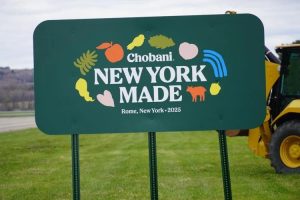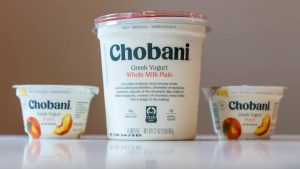
Afterward, it is pumped to a maturation room where it begins its transformation into America’s top-selling Greek yogurt. The warm skim milk is mixed with the brand’s proprietary mother culture and probiotics. After that, it is left to mature for 10 hours, the pH going down as the acid levels increase, the entire mixture turning into curds and whey. Once it is strained, the remaining yogurt is cooled to 60 degrees, which slows the fermentation process and prevents any overly sour product from forming.
It takes four gallons of milk to make one cup of Chobani’s yogurt, meaning there is a ton of whey byproduct left over. Because whey decomposition is toxic to the environment — the acidity can “burn” the land and strip oxygen from waterways, killing fish — this watery, cloudy, sugary slop can’t simply be dumped except through environmental “digesters.” Thus, you can find countless alarmist articles about whey, most all with a punny headline.
Some of this whey is given back to farmers to be used as fertilizer or, less ideally, in cattle feed, which likewise harms cows’ stomachs. Some has been used as a bodybuilding supplement, and some might even go to help power nearby factories. But with America’s appetite for Greek yogurt what it is, there’s just too much damn whey for Chobani to get rid of every single day.
While lots of companies and food scientists are busy researching and devising more environmentally friendly ways to dispose of the abundant substance, the best solution might be in distilling it into a neutral spirit that could very well become the country’s next great gin.
SOLVING A PROBLEM
“It’s completely novel to me what they’re doing,” says Andrew Said Thomas, co-owner and distiller at Brooklyn’s Halftone Spirits.
He’s talking about Eduard Zaydman and Joe Van Groll, founders of Cayuga Ingredients in King Ferry, N.Y. A Ukrainian immigrant who moved to America as a teen in 1990, Zaydman earned a degree in industrial engineering and by the aughts began looking for opportunities in the emerging bioenergy space. He stumbled upon the work of Van Groll, a biochemistry engineer employed as a Wisconsin cheese exec who had been working part-time out of his garage on creating a proprietary technique to turn whey into ethanol.
“We don’t offer anything brand new, we’re just making it much better,” Van Groll noted of his technology at the time. Still, Zaydman thought there was a ton of business potential.
They converted the Grand Meadow cheese plant in Stratford, Wis. — America’s leading cheese-producing state was creating 18 billion pounds of whey per year at the time — into an ethanol factory. Soon, they were taking whey from local cheese makers and distilling it into 5,000 gallons of ethanol per day, mainly for use as fuel. Eventually they were working with the University of Wisconsin on research and began looking to launch their own industrial project. Zaydman, meanwhile, had grown tired of traveling back and forth to Wisconsin from his home in Brooklyn.
“Then I said, ‘Wait a minute, New York is the third-largest dairy producer in the country,’” he recalls. (Today, it is actually fourth, after California, Wisconsin, and Idaho, where Chobani recently opened the world’s largest yogurt plant, at over 1 million square feet.)
The two men launched a new company, New Age Renewable Energy, and by 2016 were working on a $12.5 million dollar project set to open in Johnston, N.Y., right next door to a FAGE plant, another top international yogurt producer. But the unexpected death of a major investor halted that project when it was 75 percent done.
Around the time, Zaydman read about Lake Distilling in King Ferry, about 150 miles to the west, just south of Syracuse. The vodka distiller had recently gone bankrupt and the facility had been foreclosed on. Zaydman toured it and, though it would need to be retrofitted to handle New Age’s technology, thought it could work. The area was likewise plentiful with dairy companies, like Cayuga Milk Ingredients in Aurelius and, of course, Chobani in Chenango County.
As recently as 2020, New Age was strictly distilling the area’s whey into ethanol for industrial use, like for pharmaceuticals, flavorings, paint thinner, printer ink, and as bulk sanitizer during the early days of the pandemic. But, Zaydman, a wine connoisseur and whiskey enthusiast whose Ukrainian heritage also naturally gave him a taste for vodka (“It travels through my blood” he jokes), had ambitions to go further, and perhaps shake up the state’s distilling industry in the process.
“Obviously, whey neutral spirits don’t really exist,” he explains. “Most distilleries make certain designated spirits: whiskey must be made from grain, bourbon from corn. Even most vodkas say ‘made from grain’ on the label.”
So it seemed like a bit of a fool’s errand, except Zaydman was also aware that many of New York State’s emerging craft distilleries had farm licenses, meaning that at least 75 percent of their spirits needed to be made from ingredients produced in state. Unfortunately for New York State distilleries, much of the country’s bulk grain neutral spirits (GNS) are produced in other states: Golden Triangle Energy in Missouri, Ultra Pure in Connecticut, and MGP Ingredients out of Kansas and Indiana.
Zaydman thought he could maybe change that, while saving the environment in the process. Thus New Age Renewable Energy became Cayuga Ingredients, and Zaydman started knocking on distillery doors in Brooklyn.
SPARKLING CLEAN
“It has kind of a rum-like quality, with all these fruity esters,” says Thomas. Zaydman, who lives in the nearby neighborhood of Bay Ridge, reached out last year and dropped some samples off at Thomas’s Gowanus distillery. “I tried it and thought, ‘This could be pretty interesting.’”
Halftone had been using corn-based GNS from some of the big factories across the country, but Thomas hadn’t really been pleased with much of it. He often found himself re-distilling it upon arrival, a process that was pricey, costing him about 15 percent of the liquid each time. But with Cayuga Ingredients and its whey neutral spirit he was instantly able to use it as a base for two new gins he was formulating, a Piña Colada-inspired one made with Sabra hops and another dubbed Mojito Lime.
“The quality of the spirit was fantastic and really made all the nuances come through in the gins,” he claims, particularly loving its rich texture that tones down some of the alcohol heat. “Because whey comes from milk sugars, there is a nice creamy mouthfeel to it, which is great.”
Thomas has since begun using whey distillate for all of Halftone’s monthly releases (though he continues to use corn GNS for his London Dry flagship to retain consistency).
Upstate in Bovina, N.Y., in the western Catskills, Jake Sherry of Isolation Proof had also been using a corn-based GNS until he came upon Cayuga Ingredients. After extensive test runs, he gladly switched over to its whey neutral spirit for all his gins, including his flagship distilled with orange peel, licorice root, and cubeb, as well as a seasonal release, Winter Gin, made with wild apples, dried pears, raw honey, and Assam tea.
“I was very intrigued about using something other than grain as a base,” says Sherry. He actually believes the whey has a more neutral character than corn, which he finds a hair too sweet for his gin. It doesn’t matter that whey is naturally acidic, after distillation it is completely neutral in flavor and aroma.
“It’s sparkling clean compared to almost any other alcohol,” says Zaydman. Like Thomas, Sherry also loves the whey distillate’s mouthfeel.
“I want every nuance of flavor to pop when someone tastes our gin, and having a clean and smooth neutral spirit as the base lets all the other ingredients stand out,” he says.
Besides the great flavor, texture, and environmental impact, New York state distillers also love the price they pay for the 192 proof whey distillate, around $3 a proof gallon, Thomas tells me. Because Cayuga Ingredients strictly uses byproduct, it can pass the savings onto their customers, who are often craft distilleries operating on slim margins. In under a year, 20 New York State distilleries, including Black Momma Vodka, have started using the whey distillate.
“It’s amazing what I can do with it,” says Vanessa Braxton of Black Momma Vodka, who is currently testing out infusing the whey distillate with lavender, rose petals, chamomile, and fennel. “It’s great with natural herbs and has a wonderful taste.”
Cayuga Ingredients has even begun to produce its own vodka brand, Cayuga Clear, something it sells to stores for a mere $6 a liter.
Though Cayuga Ingredients is repurposing what would otherwise be considered waste, the process is not completely free. It reimburse dairies and companies like Chobani to transport the whey to King Ferry, which could run anywhere from $300 to $500 per tanker. But the cost of the exchange is still worth it in the end, financially and environmentally.
Also, Cayuga Ingredients’ fermentation process might be the fastest in the industry, at under 24 hours without the use of enzymes. (Compare that to the two to four days it might take to ferment corn.) After fermentation, the whey is distilled five times under a vacuum, another technology that saves tremendous amounts of energy and water (whey naturally is about 93 percent water already). Cayuga Ingredients has to be fast and economical in distilling, as the whey just keeps coming.
AN OCEAN OF WHEY
Remarkably, despite the fact it has 7,000 square feet of space, 12 employees, and such a rapid distillation method, Cayuga Ingredients is only able to use up around 3 percent of the whey in the area at the moment. Zaydman believes when his company is running on all cylinders that it may be able to distill as much as 15 percent of the whey produced in the Finger Lakes region.
That’s just one area in one state in a country that produces over 100 billion pounds of dairy byproducts per year. More needs to be done across the globe. While Cayuga Ingredients is the only large scale whey neutral spirit producer in America, there are a few smaller-scale distilleries using whey byproduct around the world. Canada has Bob’s Super Smooth Vodka. Overseas there’s Sheep Whey Gin in Tasmania and New Zealand’s Broken Shed Vodka, “the vodka of tomorrow,” according to its slogan. In Cork, Ireland, there’s Bertha’s Revenge Irish Milk Gin. And nearby, in Clonakilty, Minke Gin uses whey from local family farms.
“There’s so many places to expand to potentially,” says Zaydman, who is also now making neutral spirits from upstate apple and wine waste. “We want to grab all these byproducts, so it doesn’t hurt the environment, and then we can make valuable commodities from them.”
Today, in upstate New York, Chobani just generated a million more pounds of whey.
“Spirits are truly renewable,” says Zaydman. “And there’s still an ocean of whey out there left for us to grab.”























